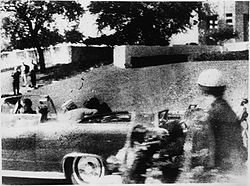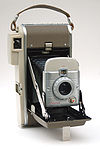- Mary Moorman
-
 Jean Hill (left) and Mary Moorman (right) as captured in Frame 298 of the Zapruder film, just less than one second before the fatal head shot
Jean Hill (left) and Mary Moorman (right) as captured in Frame 298 of the Zapruder film, just less than one second before the fatal head shot
Mary Ann Moorman (born August 5, 1932 ) was a witness to the assassination of U.S. President John F. Kennedy. She is best known for her photograph capturing the presidential limousine a fraction of a second after the fatal shot.
Contents
Biography
Mary Moorman was born Mary Ann Boshart. She married Donald G. Moorman in 1952 and divorced him in 1973.[1] She later married Gary Krahmer in 1980.
Assassination witness
On November 22, 1963, U.S. President John F. Kennedy was assassinated in Dallas, Texas.
Moorman was standing on grass about 2 feet (61 cm) south of the south curb of Elm Street in Dealey Plaza, directly across from the grassy knoll and the North Pergola concrete structure that Abraham Zapruder and his assistant Marilyn Sitzman were standing on, during the assassination. Moorman stated that she stepped off from the grass onto the street to take her Polaroid photo. Zapruder is seen standing on the pergola in the Moorman photograph, with the presidential limousine already having passed through the line of sight between Zapruder and Moorman.
She and her friend, Jean Hill, can be clearly seen in many frames of the Zapruder film.[2] Between Zapruder film frames Z-315 and 316, Moorman took a Polaroid photograph, her fifth that day, showing the presidential limousine with the grassy knoll area in the background.
Moorman's photograph captured the fatal head shot which killed President Kennedy. When she took it – approximately one sixth of a second after President Kennedy's head was shattered at frame Z-313 – Moorman was standing behind and to the left of President Kennedy, about 15 feet (5 m) from the presidential limousine.[3]
Controversy
What was captured in the background of the photo has been a matter of contentious debate. On the grassy knoll, some claim to have identified as many as four different figures, while others dismiss these indistinct images as trees or shadows. Most often a figure is identified as the "badge man" because the figure is supposedly a uniformed police officer. Others claim to see Gordon Arnold, a man who claimed to have filmed the assassination from that area, a man in a construction hard hat, and a hatted man behind the picket fence.
Moorman stated she heard a shot as the limousine passed her, then heard another shot or two after the president's head first exploded. She stated that she could not determine where the shots came from, and that she saw no one in the area that appeared to have possibly been the assassin.[4] Moorman was interviewed by the Dallas County Sheriff's Department and the FBI. She was called by the Warren Commission to testify, but due to a sprained ankle, she was unable to be questioned. She was never contacted by them again.
References
- ^ Ancestry.com. Texas Divorce Index, 1968-2002 [database on-line]. Provo, UT, USA: The Generations Network, Inc., 2005.
- ^ Moorman is visible in Zapruder frames 290 through 316. Zapruder Frames: Costella Combined Edit.
- ^ Bugliosi, Vincent (2007). Reclaiming History: The Assassination of President John F. Kennedy. New York: W.W. Norton. p. 43. ISBN 978-0-393-04525-3.
- ^ FBI interview of Mary Moorman, taken 1963-11-22, CE 1426, Warren Commission Hearings, vol. 22, pp. 838-839.
External links
- (video) includes Mary Moorman statements to media on November 22, 1963 ("This video has been removed due to terms of use violation.").
- Dallas Sheriff's Dept. Affidavit of Mary Moorman, November 22, 1963.
- Testimony of Mary Moorman in the Clay Shaw trial, 1969.
- Spartacus Educational: Mary Moorman.
- Uncropped high quality version of the Moorman Polaroid.
- The five Moorman photographs.
- JFK Online: Badge Man and the Mary Moorman Polaroid.
- Mary Moorman's Polaroid camera - Polaroid Highlander model 80A - Camera overview and User's manual.
Categories:- 1932 births
- Living people
- Witnesses to the John F. Kennedy assassination
Wikimedia Foundation. 2010.


